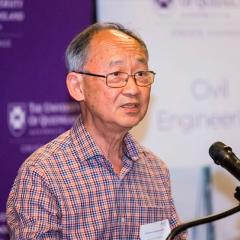UniQuest The University of Queensland’s commercialisation company, is leading Australia and competing globally in creating spin-out companies based on academic intellectual property.
Speaking at the 2018 BIO International Convention in Boston, UQ Vice-Chancellor and President Professor Peter Høj said more than 100 spin-out companies had been created based on UQ research since 1988, with most addressing unmet medical needs.
“These spin-outs have gone on to raise more than $600 million to commercialise world-leading UQ research,” he said.
“From publicly-available data, UQ is streets ahead of any other Australian university in terms of the number of spin-outs created, and among the highest performing university based technology transfer offices in the world.
“About 60 per cent of these spin-outs are in the life sciences, targeting some of the world’s most challenging diseases, including cancer, inflammation and pain.
“Others are driving more efficient and effective treatment delivery, such as needle-less vaccines and orally-stable peptide drugs.
“I’m proud that the UniQuest spin-out success rate is comparatively very high, with 46 percent still operational or having exited the market through a commercial transaction such as a trade sale.”
UniQuest CEO Dr Dean Moss said company’s spin-out success rate belied the often-cited rule-of-thumb that up to 90 percent failed.
“UniQuest’s industry-trained staff apply a rigorous technical and commercial diligence process in commercialising our academic intellectual property,” he said.
One such successful exit is Spinifex Pharmaceuticals Pty Ltd – developing a potential first-in-class oral treatment for inflammatory and neuropathic pain – which was acquired in a $1 billion deal by Novartis in 2015.
“In addition to creating spin-out companies, UniQuest has also been successful in licensing intellectual property to international pharmaceutical companies that have the infrastructure and resources to fund clinical trials and ensure that the IP reaches the market,” Dr Moss said.
“Examples include licensing the technology that led to the life-saving Gardasil cervical cancer vaccine, the magnetic resonance imaging technology to Siemens and GE Healthcare, and commercialisation agreements with international biotech companies including Merck and Zealand Pharma A/S.”
Source: National Survey of Research Commercialisation 2000-15
UQ spin-out companies include:
- Spinifex – developing a potential first-in-class oral treatment for inflammatory and neuropathic pain. Acquired in a billion-dollar deal by Novartis in 2015.
- Vaxxas – commercialising the Nanopatch technology of vaccine delivery that could replace traditional needle and syringe application. It would remove the need to use a needle, potentially eliminate the need to refrigerate the vaccine providing benefits to the developing world and could, in some cases, reduce the amount of vaccine required.
- ProGel – technology to microencapsulate ‘friendly’ living bacteria in probiotics, therapeutic biologics and drugs to help retain its integrity through the acidic stomach environment.
- NexGen Plants – a novel non-GM technology to introduce pathogen-resistance, production or consumer traits in crops.
- EMVision - a portable, non-invasive brain scanner that produces 3D images of the brain instantly.
- Fultec - a wide bandwidth circuit protection device used against lightning, power induction, power cross and short circuit events.
- ResApp Health Ltd - smartphone technology that can instantly and accurately identify respiratory diseases such as asthma or croup.
- Spin Systems, later Magnetica - magnetic resonance imaging technology.
- Hydrexia- a low pressure hydrogen storage system with high storage densities that are safer and more cost effective than existing compressed gas systems.



